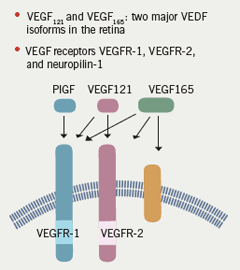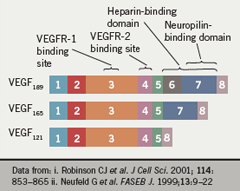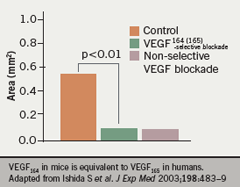Vascular endothelial growth factor (VEGF) plays a pivotal role in stimulating abnormal neovascularisation, a key characteristic of neovascular age-related macular degeneration (so-called wet AMD).1 VEGF is a secreted protein that is able to diffuse and trigger mitogenic activity in endothelial cells.2 It is produced by multiple retinal cell types, and blood vessels in the retina have several receptors for VEGF. It is known that VEGF inhibition can both prevent and reverse breakdown of the blood–retinal barrier.3 Indeed, elevated VEGF levels have been linked to neovascularisation and vascular permeability.(4-8) Consequently, it is proposed that VEGF inhibition could block the underlying pathogenic process of wet AMD.
However, VEGF is an intercellular signalling factor with numerous functions throughout the body. These functions can be both physiological and pathological: examples of these functions are provided in table 1.

The VEGF system
VEGF is not a single protein but rather exists in a number of different isoforms (figure 1). These isoforms differ in the number of amino acids contained in the mature secreted protein and, most importantly, in their solubility and heparin-binding properties.9,10 The solubility of the isoform influences its ability to diffuse in the extracellular space and heparin-binding properties influence the extracellular matrix interactions of the individual isoform. The balance of solubility and heparin binding provides the spatial cues to initiate a precisely branched vessel network.11 A further level of complexity is added by the existence of proximal and distal splice forms: proximal splice forms are pro-angiogenic whereas distal splice forms are anti-angiogenic.12 A switch in splicing from anti-angiogenic to pro-angiogenic isoforms of VEGF may be associated with diabetic retinopathy.12


In the eye, VEGF121 and VEGF165 are the major isoforms: VEGF145 and VEGF206 are not detected in the eye. High-affinity receptors for VEGF are expressed by endothelial cells. VEGF receptor 1 (VEGFR-1) and VEGF receptor 2 (VEGFR-2) bind to all isoforms of VEGF. In contrast, neuropilin-1 binds specifically to VEGF165 via the exon-7-encoded domain of VEGF, which VEGF121 lacks. Neuropilin-1 is thus recognised as a VEGF165-specific receptor.9
VEGF and neuroprotection
The complexity of the VEGF system, utilising different isoforms and receptors, permits many functions for VEGF, some of which are beneficial and others detrimental. Recently, new roles in motor neuron development have been elucidated for VEGF. Studies in mice indicate that VEGF is involved in the coalescence of motor nuclei: disruption of the VEGF system results in a delay in migration of these cells.13 These findings could have important implications for neuron preservation in the eye.
When the eye is subjected to an ischaemic insult, retinal neurons become apoptotic; in the presence of VEGF, apoptosis is greatly reduced.14 However, if a long period of ischaemia (60 minutes) is preceded by a short period of ischaemia (five minutes), there appears to be a level of protection afforded, known as ischaemic preconditioning. VEGF is thought to play a very important neuroprotective role in this ischaemic preconditioning. Indeed, if VEGF is injected into the eye following ischaemic insult, the majority of neuronal cell death can be prevented. It has been found that VEGFR-2 is present not only in the blood vessels but also on neurons and glia within the retina, providing a potential mechanism for this neuroprotective effect. By contrast, chronic suppression of the VEGF system leads to retinal ganglion cell death, which could have important implications for the use of anti-VEGF therapy in wet AMD.
VEGF and inflammation

Evidence suggests that the VEGF165 isoform has pro-inflammatory properties.15 VEGF165 blockade preferentially inhibits pathologic retinal neovascularisation. Indeed, VEGF165-selective blockade and non-selective VEGF blockade inhibit pathologic neovascularisation to a similar extent (figure 3).8 In VEGF164-deficient mice (VEGF164 in mice is equivalent to VEGF165 in humans), no neovascularisation in the flat mount retina is observed, in contrast to wild-type mice where abnormal angiogenesis and vascular tuft formation are present.15
VEGF165 has been shown to be the most potent of the VEGF isoforms at creating leukocyte-based inflammation.15 It is likely that the pro-inflammatory activity of VEGF165 contributes to the development of wet AMD. Inflammation plays an important role in AMD.16
Conclusion
VEGF has numerous physiological roles that must be considered when developing treatments for chronic conditions that may affect VEGF functionality in the body. More research is required to develop understanding of the different roles of VEGF isoforms in normal physiological functioning and the pathogenesis of disease.
At present, pan-VEGF inhibitors are used in both oncological and ophthalmological settings. There is a growing list of safety concerns as experience with these agents increases, although at present the benefits are considered to outweigh the risks. The risk/benefit will need to be continuously monitored as these agents are used longer-term, as preventive agents and for the potential treatment of diabetic retinopathy which is currently being investigated in the clinic. More selective VEGF inhibitors may provide an attractive option for treating patients with a higher risk profile.
Conflict of interest
Professor Shima: none declared.
References
- Ambati J, Ambati BK, Yoo SH et al. Age-related macular degeneration: etiology, pathogenesis, and therapeutic strategies. Surv Ophthal 2003;48:257–93.
- Ferrara N, Houck K, Jakeman L, Leung DW. Molecular and biological properties of the vascular endothelial growth factor family of proteins. Endocr Rev 1992;13:18–32.
- Qaum T, Xu Q, Joussen AM et al. VEGF-induced blood-retinal barrier breakdown in early diabetes.Invest Ophthalmol Vis Sci 2001;42:2408–13.
- Adamis AP, Shima DT, Tolentino MJ et al. Inhibition of vascular endothelial growth factor prevents retinal ischemia-associated iris neovascularization in a nonhuman primate. Arch Ophthalmol 1996;114:66–71.
- Krzystolik MG, Afshari MA, Adamis AP et al. Prevention of experimental choroidal neovascularization with intravitreal anti-vascular endothelial growth factor antibody fragment. Arch Ophthalmol 2002;120:338–46.
- Aiello LP, Pierce EA, Foley ED et al. Suppression of retinal neovascularization in vivo by inhibition of vascular endothelial growth factor (VEGF) using soluble VEGF-receptor chimeric proteins. Proc Natl Acad Sci USA1995;92:10457–61.
- Amano S, Rohan R, Kuroki M, Tolentino M, Adamis AP. Requirement for vascular endothelial growth factor in wound- and inflammation-related corneal neovascularization. Invest Ophthalmol Vis Sci 1998;39:18–22.
- Ishida S, Usui T, Yamashiro K et al. VEGF164-mediated inflammation is required for pathological, but not physiological, ischemia-induced retinal neovascularization. J Exp Med 2003;198:483–9.
- Robinson CJ, Stringer SE. The splice variants of vascular endothelial growth factor (VEGF) and their receptors. J Cell Sci 2001;114:853–65.
- Neufeld G, Cohen T, Gengrinovitch S, Poltorak Z. Vascular endothelial growth factor (VEGF) and its receptors. FASEB J 1999;13:9–22.
- Ruhrberg C, Gerhardt H, Golding M et al. Spatially restricted patterning cues provided by heparin-binding VEGF-A control blood vessel branching morphogenesis. Genes Dev 2002;16:2684–98.
- Perrin RM, Konopatskaya O, Qiu Y, Harper S, Bates DO, Churchill AJ. Diabetic retinopathy is associated with a switch in splicing from anti- to pro-angiogenic isoforms of vascular endothelial growth factor. Diabetologia2005;48:2422–7.
- Schwarz Q, Gu C, Fujisawa H et al. Vascular endothelial growth factor controls neuronal migration and cooperates with Sema3A to pattern distinct compartments of the facial nerve. Genes Dev 2004;18:2822–34.
- Nishijima K, Ng YS, Zhong L et al. Vascular endothelial growth factor-A is a survival factor for retinal neurons and a critical neuroprotectant during the adaptive response to ischemic injury. Am J Pathol 2007;171:53–67.
- Shima D, unpublished data.
- Anderson D. A role for inflammation in the formation of drusen in the aging eye. Am J Ophthalmol 2002; 134: 411–31.
